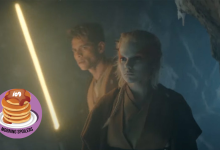
Thrawn’s Theme, Baylan, and More
For almost two decades and across generations, the Kiner family has helped shape the sound of Star Wars animation—and now with Ahsoka, they, like the former Jedi, have made the leap into the live-action side of the galaxy far, far away. As Ahsoka brings its season to an end this week, we sat down with the Kiners to talk about the character’s musical evolution.
Kevin Kiner has composed Star Wars music since the 2008 Clone Wars movie—and has now had the chance to not just see Ahsoka grow as a character across it, the Clone Wars TV show, Rebels, and now Ahsoka, but also watch his own children Deana Kiner and Sean Kiner musically flourish in the Star Wars galaxy with their own work alongside their father on Clone Wars’ final season, Rebels, Bad Batch, and Ahsoka. And yet, the idea of working on Star Wars still has ways to charm and surprise the family all these years later.
“You know, yesterday evening we were having dinner, my wife and I, and we’d been doing a lot of press for promoting the soundtrack, something we’re really proud of. And when I talk to the press, which is not that often, it kind of drives home and reminds me that I’m doing Star Wars. In 1977, I was at UCLA and went to see the movie and all the midnight showings… Superman and Star Wars are the reasons I wanted to become a film composer. I wanted to make that sound. Here’s this guy making this magical sound, that transports you into this fantasy world. I grew up reading Tolkien and love fantasy and Asimov and Ray Bradbury. I’m still reading science fiction now. I always loved it,” the Kiner patriarch recently told io9 over Zoom. “So, the perspective that you guys give me—Ahsoka being the face of Disney+? My god. So I just said to my wife, ‘You know, I’m doing the music for Star Wars.’ I said that last night. She looks at me like, ‘Huh?’ But… wow. It’s beyond description. I’m much better with music than I am with words!”
Check out the rest of our interview with Ahsoka composers Kevin, Deana, and Sean Kiner, condensed and edited for clarity, below.
James Whitbrook, io9: I wanted to start off by asking the process of you coming aboard Ahsoka. You’ve had a deep, long, extended history with Star Wars for nearly the past two decades, doing work on the animated shows. What was the process like when you heard Dave Filoni was going to bring this character into her own live-action series? Were you waiting for the call to come?
Kevin Kiner: The past two years! They played it really close to the vest. In fact, I had a plan once (Dave Filoni) told me I was doing the show—because it was just this excruciating waiting period—I was doing work, I knew he was working on it, it was happening… they hadn’t announced the composer… so, when I found out we were doing it, you know, it was like “He could have told me sooner!” But everything had to fall in place. But still, I was going to go up there and punch him. I was going to give him a hug, and punch him. But instead—it was actually the wrap party for season two of Bad Batch, it was a secret, we couldn’t really talk about it—but Dave looked at me and I gave him a big hug, and then I did not punch him.
Deana Kiner: And then we kept the job!
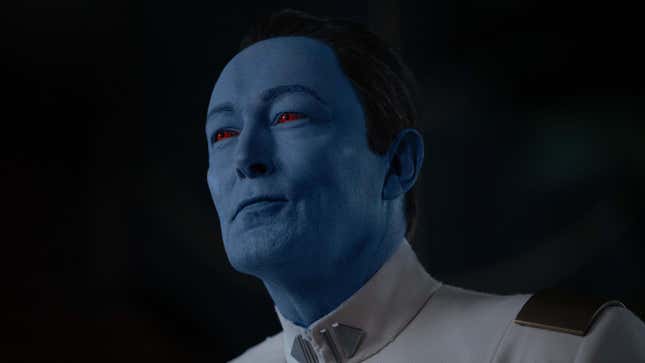
io9: Were there challenges adapting to composing music for episodes that are 40-50 minutes long, instead of the 20-30 of an animated series?
Kevin Kiner: You know, it’s funny. One of the things that comes up is “how is it different? Scoring live-action versus animation?” And there are differences, but when you just asked me that, it crossed my mind with something I hadn’t said before… all three of us wanted to do the best music ever written on Earth, so badly. And we were all just so absolutely intent on every cue we wrote just being an absolute home run, and the best thing we’ve ever done. I think that kind of shows in the soundtrack. I love baseball analogies. I’m a baseball fan. You know, if you squeeze the bat too hard—and you try too hard—you’re going to strike out. So that’s a challenge. When you really want to do something great. Another part of that is you can overwrite, too, in places where the music just needs to settle and let the actors do their job. The music is there for a mood for 20, 30 seconds—whatever it is—don’t overwrite it. Even though you’re trying to write your symphony, don’t write your symphony in those places.
Deana Kiner: We’re kind of lucky to be working with the three of us together, and I think that ends up being really helpful. To be able to go up to each other and say “hey, is this going too far? Have I overwritten this?” Or, “is this not enough?” even. I think having the three of us really helps alleviate that kind of weight and stress and really makes our songs a lot better.
Sean Kiner: After we were told we had the gig, we had a lot of time before we actually got the first episode, and so between the three of us, we started workshopping things, and having the kind of time to just start bouncing things back at each other was also really valuable.
Kevin Kiner: I was out of town when I found out we had the gig, so I called the kids—and I think you stayed up all night writing.
Sean Kiner: It was all this nervous energy we had to write out onto the page.
Deana Kiner: All this adrenaline and nowhere to put it, basically. Might as well start writing. And then we were like, “is it too early to be doing this?” Second guessing. Then everything hooked and I think really helped us figure out how we wanted to approach the show and what would and would not work.
Sean Kiner: Of course the second we got the picture, 99% of what we had done went out the window. It was useful to have all that failure behind us, already.
Kevin Kiner: Kind of like working out, you stretch, getting your muscles ready. (laughs)
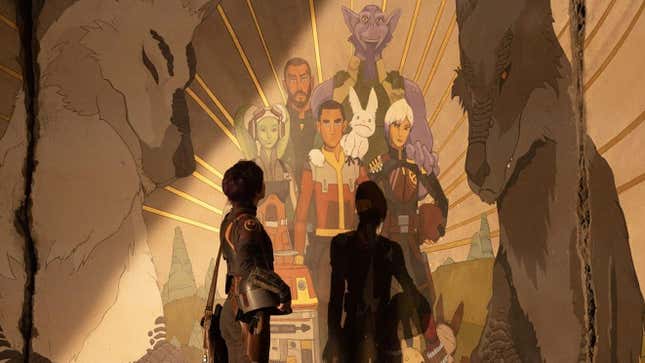
io9: It’s not just Ahsoka that’s coming back, it’s a soft sequel to Rebels. You’re dealing with these characters you’ve worked with for so long, and developed a kind of soundscape for. When you’re coming into the early stages of the scoring process for Ahsoka, how did you go about wanting to revisit that prior work and those themes you’ve already established? How did you evolve the new sound for this show, specifically?
Kevin Kiner: Part of how it’s different working on the live-action shows than the animated shows is that we have more time. We have more back-and-forth with Dave. I think one of our tendencies is, “Oh, it’s Sabine! Let’s play her theme!” No, that’s not what this needs. And Dave had to pull us back a couple times because—same thing with Thrawn,“Oh, let’s do the organ and everything!” No, it’s not about the music here, it’s about Thrawn’s entrance. Make it heavy as hell. We can have Thrawn’s theme in there, but… again, we’re such soundtrack geeks, we’re such Star Wars geeks, we’re such Rebels geeks, and we wrote those themes… and we’re very attached to them. So your first instinct, yeah, I’d say it’s kind of the same thread. Dave pulled us back from being too enthusiastic. From being eager little puppies, you know? “Okay, settle down guys.”
Sean Kiner: But he refocused us on the story. Refocused us on the energy of the story, rather than the pre-existing legacy themes. That’s really what we did in order to evolve the sounds. We had to take stock of where the characters are now, what they’re going through and adapt the melodies and lines to what their current story needs.
Deana Kiner: I found one of the places I found ourselves being really successful was with Ahsoka and Hera, and the way their relationship has changed. They’re in very different places in their lives. They have a very different relationship now that they’ve been working together so much more. It was really fun to approach that in a different way. And obviously, Dave is so great to work with because he encourages us to swing for the fences. He’s like, “Go for it. You have a crazy idea? Let’s try it.” That’s how Sabine’s song, “Igyah Kah” turned out, because he was like “let’s try something crazy. Let’s really go for it.”
Kevin Kiner: Let’s rock ‘n roll.

io9: It turned out great!
Kevin Kiner: Thanks a lot! There was another piece when they’re at the Corellian Shipyard (in episode two), and Ahsoka and Hera are having a really serious talk, and Hera says, “when is it enough? How do you know? When is somebody going to be good enough for you?” And that was a heavy moment. And I think the score successfully navigates that moment. The themes are still there, but there’s a maturity to them. It’s playing that moment, too.
io9: Ahsoka’s theme has become such an important leitmotif to a lot of fans and how they perceive the character. When you’re dealing with a piece like that which has such a presence and reputation now, how did you approach evolving it for the new show?
Kevin Kiner: It’s funny, that melody was a gift, you know? I don’t know where it came from, but I remember what the scene was and where I was when I wrote it 17 years ago. It was the first theme I’d ever written for George (Lucas). I’d just been hired and it came really quickly, which a lot of the good ones do. I think what happened then is that there’s these two kinds of… it started with Tales of the Jedi, the three episodes deal with Ahsoka’s birth and growing up, and Dave had this concept, it was very much his homage to those Studio Ghibli movies. So there was a big kind of Japanese samurai, ronin influence. (Deana and Sean) really took that theme and those few notes and changed them and yet kept them the same. And kind of added this droning cello, ronin-esque pulse to it. Then it’s a variation in many different ways of Ahsoka’s theme. You hear that in the end credits. It starts with that.
Sean Kiner: Ahsoka’s theme was the leaping off point for that. We wanted to— we immersed ourselves in classic samurai films and listened to those sounds and ended up coming up with what you hear at the beginning of the end credits. But it’s been very useful to have both the mature samurai warrior sound and Ahsoka’s theme—the soul of the character. We’ve had this huge tool kit. It’s been a boon to have all these different tools when we’re trying to help the story.
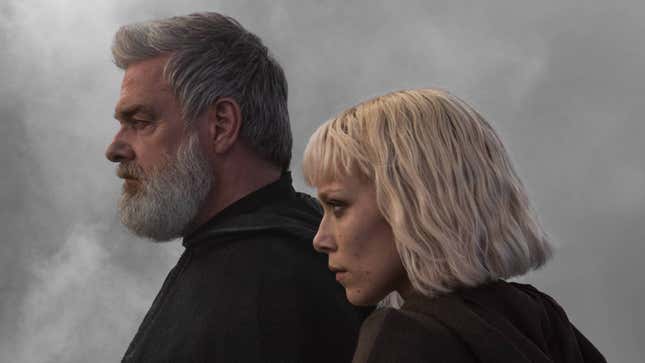
io9: I wanted to ask about your approach to Baylan Skoll and Shin Hati. How did you create their villainous, Sith-y sound? It feels similar to past Star Wars villains, but they have this very unique sound, as well.
Kevin Kiner: Something with him—and Sean, you can speak to this as well — a piano is lightly used, usually, in Star Wars. Not that often. So (Baylan’s theme) is kind of something new. You don’t usually have a big, bashing piano accompanying the bad guys in Star Wars shows. So that was kind of cool.
Sean Kiner: Interestingly enough, piano does peddle down on the bass of “Duel of the Fates.” It doesn’t carry the melody like we do the Baylan, but we knew it was something we could bring into Star Wars. For Baylan, specifically, we voiced the piano in this Rachmaninoff-type voicing, so we went back and referenced some classical elements. And then we made a variation of the Dies Irae, which is this medieval music associated with death and the ending of things.
Kevin Kiner: Sort of like a Gregorian chant. It’s a liturgical piece of music.
Sean Kiner: And then we brought in the orchestras. You can hear it in the hallway scene. I forget the track’s name on the soundtrack. Then we kind of played it with a heavy metal mentality in the orchestra. So it’s all those elements playing together to make him feel imposing and implacable.
Deana Kiner: “Master and Apprentice.”
Kevin Kiner: And that’s the title of the first episode, too. And that’s Baylan’s theme. And it rocks pretty hard, you know? And then it’s Shin’s theme, also, and that’s the first episode, too. “Shin vs Sabine,” the first time you hear her theme playing… there are quite a few new themes in Ahsoka. Shin’s, Baylan’s, the New Republic theme, Morgan’s theme—we just named it Morgan’s theme, one of the witches’ themes. I will say, as an aside, that it breaks my heart every time somebody even says Baylan Skoll. Watching this show, all of this breaks our heart. He was so marvelous. What a loss.
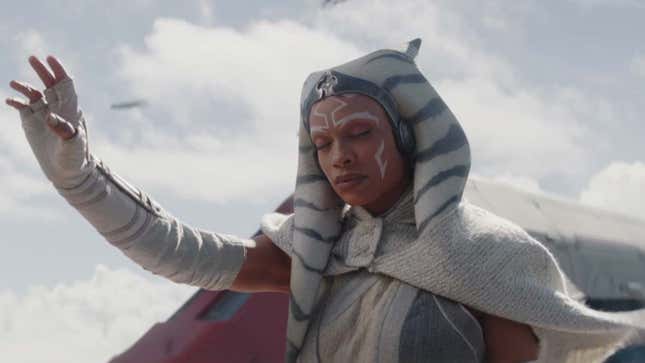
io9: Kevin, you’ve been part of Ahsoka’s journey from the very beginning— and then you got your family involved, and now you’ve all worked on Clone Wars, and Rebels, and Bad Batch, and now Ahsoka. How has it felt for you all to watch this character grow in that time?
Sean Kiner: As composers, our lives are very solitary and so our relationships with these characters are very personal and intimate. But whenever I catch a glimpse of the millions of people that are being affected by the work we’re doing, I feel a distant connection to them. It’s very profound and fills me with a lot of emotion.
Kevin Kiner: My wife is Filipina, so every other year we go to the Philippines so (her parents) can be with their grandkids. We went out to Mt. Pinatubo, which erupted a few years earlier—and it’s in a very remote part of the Philippines. You have to get on a four wheel drive for a couple hours to get out to it, and we go to this volcano which now has been filled with rain. And I look over and there’s this little kid running around in a t-shirt, and I’m looking at it, and it’s a Clone Wars t-shirt. In the middle of fucking nowhere. This is not a relative of mine, or anything. It was just somebody who was there. So, boy, is it ever worldwide.
Ahsoka is now streaming on Disney+.
Want more io9 news? Check out when to expect the latest Marvel, Star Wars, and Star Trek releases, what’s next for the DC Universe on film and TV, and everything you need to know about the future of Doctor Who
اكتشاف المزيد من موقع دبليو 6 دبليو
اشترك للحصول على أحدث التدوينات المرسلة إلى بريدك الإلكتروني.
